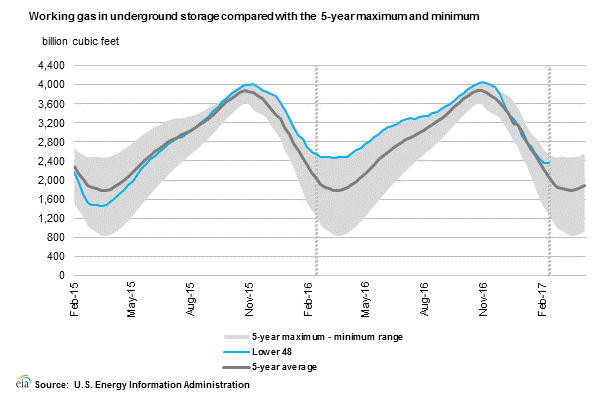Energy cost management implications of higher temperatures
For the second consecutive Winter, most of the US has experienced warmer-than-normal temperatures. According to a Financial Times article titled “Warm US winter leaves natural gas market with excess supplies”
…this heating season has been running 3 per cent warmer than last year, weighted for population, according to the US National Weather Service. Over the past 30 days, more than 700 monthly high temperature records were set across the country, while only one low record was made.
During the week of February 24th, the EIA reported that there had been an unprecedented gas storage injection during the Winter– it is unheard of to inject gas into storage during winter months when heating demand is supposedly at its peak. Bloomberg reported on this phenomenon here as did Forbes, here.
What are the implications for energy costs?
Natural gas prices have fallen on this news and the lack of demand that has resulted from warmer-than-normal temperatures. While this may be short term good news for buyers, to the extent that it causes disruption and financial hardship on gas suppliers (who may continue to shutter production facilities and reduce investment in new production), the medium to long term impacts may not be great for buyers and financial decision makers.
What are the implications of warmer weather on you, financial decision makers and energy buyers?
What is normal, after all? There are a few risks that are presented when buyers in complex markets are faced with major deviations from normal costs or temperatures.
First, in the short term, you run the risk of over-insuring. If you don’t have a good, accurate forecast of cost and usage, and you choose to fix large components of your costs, you run the risk of over-buying or buying too much of your commitments on a fixed contract, particularly in the Winter.
Second, in the short term, you will likely miss your budget goals. Budgets are guidelines. Of course you aren’t going to hit your goal, but you will likely find yourself under-budget, especially if you typically buy some percentage of costs on an index rate. You may find that both your actual usage and your actual costs are lower than your original forecast. You may be a hero today, particularly in difficult budget times, but what really matters is what you do next….
Third, in the medium term, you run the risk of not providing an accurate forecast the next time you submit a budget. You can not rely on your most recent results when you plan for your next fiscal year. You may find that your administrative colleagues and finance professionals will come to expect you to deliver a budget forecast that mirrors your actual costs. When you submit budgets based on “normal” weather, your colleagues will ask you why you would expect costs to perhaps be higher next year as compared to this year. The only way to be comfortable about submitting budgets year after year is to use normal weather to forecast your cost and usage. Make sure you are using a weather normalization process when you prepare your budgets for the next fiscal year.
This is particularly true when there is so little agreement as to the direction of natural gas prices over the future months. As a contributor to Forbes explains, despite all time high storage numbers last year, natural gas prices increased 50% between March and the summer last year. Jude Clemente writes (and we agree):
There’s an inherent “you never know” factor in the U.S. gas market: trader and speculation influence on gas prices is probably in the 20-30% range.
Others, like this reporter from Bloomberg, may not agree as to the likely future of gas prices. Liam Denning of Bloomberg looks at the data and deems it “weird” (primarily because of the uptick in storage in February of this year).

So what is an energy manager or financial decision maker to do? Here’s our advice.
Bottom line for energy and finance professionals. Stick to your process. Don’t let one month of low prices and mild weather lull you into complacency. Don’t let two warm Winters throw you off your strategy. There is no substitute for planning and management. Effective energy cost management is a continuous process, not an episodic series of decisions.
